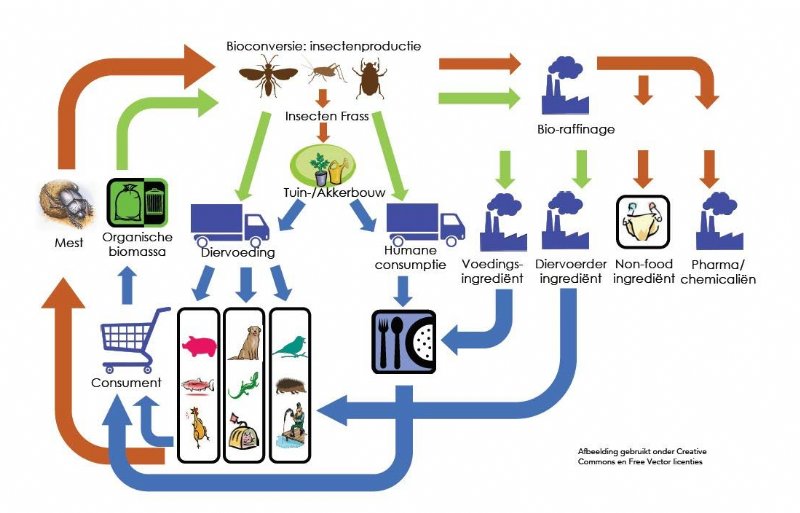The Netherlands is currently a global leader in insect farming. Insects are commercially produced on a small and large scale for food, animal feed and technical applications.
Where livestock farming is under pressure, this is just the opposite in the insect sector. There is a lot of investment in research and development. The sector size is growing. Insects require little space and water during production, grow quickly and efficiently, can grow on organic residual flows and produce a small amount of greenhouse gases. This makes the production of insects a lot more sustainable than the production of other animal protein.
In 2009, the government already included insects in the Sustainable Food memorandum and the Innovative Protein Chains Program. Since then, interest in the development of a sustainable insect chain in the Netherlands has increased significantly.
Insect production locally ensures a circular upgrading of food waste and other organic residual flows. Moreover, the side stream of frass, skins and excrement can be used as a natural soil improver.
The insect sector is growing fast in the Netherlands. More and more companies are switching. Entrepreneurs from the pig and fur sector in particular are particularly interested in switching. Other agricultural companies, especially poultry farms, see the broadening of their business activities in the production of insects.
The market perspective is favorable, according to the trade association Venik. The demand for insects and insect products is currently greater than the supply. For regular application in animal feed, a large quantity of constant quality, constant delivery and a competitive price is essential. To respond to this, an upscaling of the insect chain is necessary. New and companies are therefore investing in large-scale insect production.
A study by the International Platforms of Insects for Food and Feed (Ipiff) shows that there is enormous growth potential for the insect sector in Europe. Insect protein production is currently very modest. If all brakes are released, a production of 5 million tons of insect protein by 2030 would be possible.
Until now, insects can only be used to a limited extent in animal feed. Insect proteins are expected to be included in poultry feed after this year. Studies show that in addition to fats, proteins and minerals, insects also contain components such as chitin, lauric acid and antimicrobial peptides. These have antimicrobial activity and promote immunity.
The insect sector has firm and ambitious goals for 2030. Far-reaching modernization of a welfare-friendly production method and innovations in the field of food safety and public health will make the sector an indispensable link in circular agriculture by then. In about eight years, insects will process a third of the local organic residual flows and the insect sector will produce energy and CO2 neutral.
In addition, half of the fishmeal that is still processed in Dutch animal feed will be replaced by insect protein. A fair earnings model and being able to work in a safe and pleasant environment are important preconditions, according to Venik. This also applies to the cultivation and processing of insects with minimal disruption to the environment.

The circular vision of the insect sector © Venik
Source: https://www.nieuweoogst.nl/nieuws/2021/05/11/insectensector-ontpopt-zich-tot-kleurrijke-en-dynamische-keten


